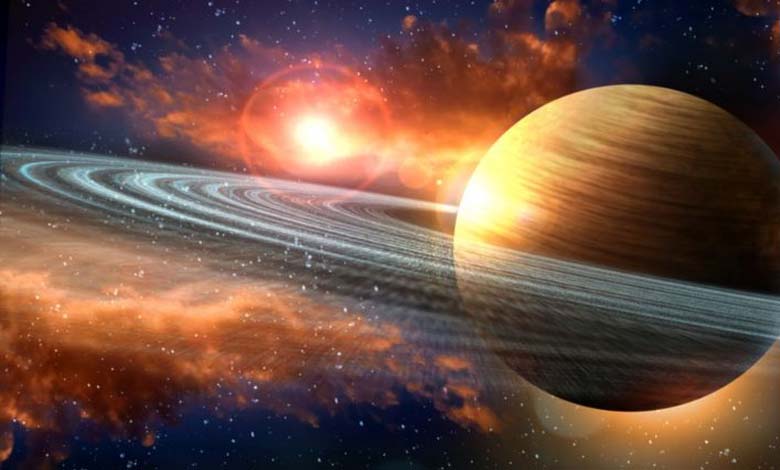Saturn’s Rings Disappear: A Rare Astronomical Phenomenon That Occurs Only Every 15 Years

Recently, the Earth’s night sky became the stage for a truly remarkable and rare astronomical event: the temporary disappearance of Saturn’s magnificent rings. This intriguing occurrence, scientifically known as the “ring plane crossing,” happens when the planet’s vast and spectacular ring system aligns perfectly with our line of sight from Earth, rendering them nearly invisible.
-
A Rare astronomical phenomenon… ‘Scorpius Heart’ to eclipse behind the moon
-
What is a solar storm, this astronomical phenomenon that occurred last night?
For centuries, Saturn’s rings have fascinated astronomers, skywatchers, and space enthusiasts alike, standing as one of the most recognizable and awe-inspiring features of our solar system. However, approximately every 13 to 15 years, these iconic rings appear to vanish from view in an optical illusion caused by the precise alignment of Saturn, its rings, and Earth.
A Rare and Challenging Event to Observe
Although this phenomenon is scientifically well-documented, observing it is far from easy. The 2024 occurrence of the ring plane crossing posed significant challenges for skywatchers, particularly those located in mid-northern latitudes, where Saturn’s position in the sky placed it very close to the rising Sun. The intense brightness of dawn made it exceedingly difficult to distinguish the planet and its faintly visible rings.
-
A rare phenomenon… ‘Red Planet’ disappears from Earth’s sky
-
A Solar Storm Heading Toward Earth Could Cause Communication Outages
On the other hand, observers in mid-southern latitudes had a relatively better chance of witnessing Saturn’s ring disappearance. Even so, the brightness of the early morning sky remained an obstacle, requiring clear conditions, precise timing, and advanced telescopic equipment to capture the subtle details of the event.
This astronomical event serves as a reminder that space phenomena are often fleeting, requiring patience, skill, and a bit of luck to observe.
The Science Behind the Ring Plane Crossing
Saturn, the sixth planet from the Sun and the second-largest in our solar system, takes 29.4 Earth years to complete a full orbit around the Sun. As it follows this elongated path, the 27-degree axial tilt of Saturn plays a crucial role in determining how its rings appear from our vantage point on Earth.
-
Bright lights dazzled the sky with colors and beauty
-
Discovery of the Origin of Iron on the Moon’s Surface… and Astronomers are Puzzled
Over the course of this lengthy orbit, there are periods when the rings are fully illuminated and tilted toward us, showcasing their immense grandeur. At other times, the rings shift to an almost edge-on position, making them appear as a thin, barely perceptible line or even disappear altogether.
The disappearance of Saturn’s rings does not imply any physical change in their structure but rather a purely visual effect caused by their extreme thinness. Although the rings span an astonishing 170,000 miles (273,600 kilometers) in diameter, their thickness is shockingly small—measuring only about 30 feet (10 meters). When seen edge-on, they become nearly invisible, resembling a razor-thin structure that blends seamlessly into the darkness of space.
What Are Saturn’s Rings Made Of?
Saturn’s rings are primarily composed of water ice, making up about 95% of their composition, while the remaining portion consists of small rocky fragments and dust particles. Scientists believe that these rings formed from comets, asteroids, or even moons that were shattered by Saturn’s immense gravitational forces millions of years ago.
Despite their delicate and ethereal appearance, Saturn’s rings remain one of the most mysterious and studied structures in the solar system. NASA’s Cassini spacecraft, which spent over a decade studying the planet before plunging into its atmosphere in 2017, provided groundbreaking insights into the rings’ structure, composition, and potential lifespan.
-
“James Webb” contributes to deciphering the chemical code of the “Hot Saturn” planet
-
Revealing the Lifespan… Redefining habitable worlds beyond earth
Some research even suggests that Saturn’s rings might be slowly disappearing. Over millions of years, the gravitational pull of Saturn is drawing icy particles inward, leading to a gradual “ring rain” effect. If this process continues, the rings could eventually fade away—though not for at least 100 million years or more.
A Temporary Disappearance Before a Spectacular Comeback in 2032
While the ring plane crossing of 2024 has temporarily hidden Saturn’s rings from view, this effect is only temporary. Over the next several months and years, the tilt of the rings will gradually increase, making them more prominent once again.
-
A meteor shower every minute… A meteor shower illuminates the sky of the region
-
Perseids every minute… Meteor shower illuminates the region’s sky
By the year 2032, Saturn’s rings will reach their maximum tilt, presenting an unparalleled spectacle for astronomers and space enthusiasts. During this period, the rings will appear in their fullest, brightest, and most detailed state, making it one of the best times to observe Saturn in all its glory.
For those eager to catch the best view of Saturn in the near future, mark your calendars for September 21, 2025. On this date, Saturn will reach opposition—the moment when the planet is directly opposite the Sun in the sky as seen from Earth. This alignment will provide optimal viewing conditions, with Saturn shining brightly and being fully illuminated, making it a prime opportunity to observe the gas giant, its rings, and even some of its largest moons through a telescope.
-
Whirlpools on the Moon… Study reveals the secret of “shiny wrinkles”
-
New secret about the “most violent event in earth’s history
A Reminder of the Wonders of the Universe
The temporary disappearance of Saturn’s rings is a fascinating reminder of the dynamic and ever-changing nature of the cosmos. Even the most recognizable celestial features can undergo apparent transformations due to the intricate dance of planetary motion and alignment.
For astronomers, both professional and amateur, these periodic celestial events offer exciting opportunities to study, photograph, and appreciate the mechanics of our solar system. And for casual stargazers, they provide a chance to marvel at the sheer complexity and beauty of the universe.
So, while Saturn’s rings may have briefly faded from sight, they will soon return—stronger and more magnificent than ever, offering future generations another opportunity to witness one of the most spectacular sights in the heavens.












